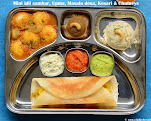If you are gloating over solving the day’s Wordle on your third attempt, try the daily breakfast/tiffin conundrum. For someone like me who hates cooking, this is the worst puzzle that tires me out at the start of the day.
Most of you may have your favourite word to start solving the daily
Wordle puzzle. The keyword that you rely on to find the word of the day in
minimum attempts. Similarly, I have one for my breakfast riddle. But this one’s
usually towards the end. After exhausting the options of Idli, Dosa and Pongal,
this serves as my saviour of the morning dilemma. Yes! You guessed it right!
As copy editors, we were always taught this universal thumb rule to
follow when editing a story: When in doubt, cut it out. Similarly, I follow a
standard proposition to crack my tiffin conundrum: When everything is out, bring upma out.
Ah! Was that my son frowning at me? Never mind. That is a universal
reaction from most people across the country. I have never understood why a
breakfast item as simple and as versatile as Upma elicits such
contempt from many. When Mamas and Thathas have
nothing to forward in the family WhatsApp group, they dig up some Upma joke
to send to all. I strongly condemn that!
What beats me is why people disparage this rustic dish for no reason. It
is my personal favourite. It is the trusted companion of many folks who rustle
it up in a jiffy when everything else fails. The dish is so complete that it
needs nothing alongside, unlike its counterparts that need chutney or sambar to
go with them. Even dried-up Idlies can be turned into tasty Upma!
This modesty and minimalism have made Upma a staple
dish across the country. Though Upma is the most generic name, it
goes by other names such as Uppittu (Karnataka), Uppindi (Telugu), Saanja (Marathi)
and Rulanv (Konkani) too. Come to think of it, it is no less
than a national dish!
A good Upma can neither be watery nor dehydrated, not
too oily or dry and not have veggies that are mushy or raw. Achieving the right
texture for the dish is an elusive one. It is like a spiritual practice that
you master only through repetition. Once you grasp the technique, it opens a
host of options; Upma can be made with sooji, semolina, wheat,
rice, poha, oats, millet, corn, bread, or quinoa, each offering a unique taste. When mixed
with vegetables, it also becomes a nutritious meal for all those calorie-conscious
and weight watchers. Now, I should remember to sell that point to my husband!
To me, Upma is an embodiment of spiritual knowledge. Let me elaborate: When we put various ingredients in the hot oil to prepare the dish, some splutter, some darken, some quietly sink it all in, and some use the heat to their advantage to become tastier. Isn’t life the same? When faced with adversity, some people throw tantrums, some complain, some wilt, while some bear it all and become better. Once the water and the base material of one’s choice are added, they blend to form a tasty dish. Similarly, when we let spiritual thoughts into our minds through any chosen path, we let go of our prejudices and mingle with everyone.
As I pat myself on that thought, I feel a slight tap on my shoulder.
“Why are you staring at the fridge with its door open for so long?” asks my
husband. “Maavu (batter) illaya?” he asks with a tinge of horror spreading on
his face. Just then, my son scoots off to work, declaring he does not want
breakfast today.
What do these mundane folks know about the greatness of Upma? Their
time is yet to come!
There is no sincerer love than the love of food. - George Bernard Shaw


Comments
-Bijoy
Upma couldn't have been better described, and finally your comparison of Upma and man's situation is really awesome.
Keep writing ✍️ ✨️ ��
Vimala